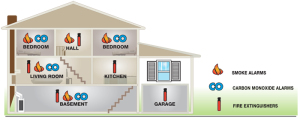In honor of October being Fire Safety month, it would be most beneficial for you and your family to make sure that your home is prepared in the event tragedy strikes and a fire breaks out. Do you know exactly how much time you have to safely get out of your house if a fire does occur? Much to my own surprise, you may only have just two minutes. Yes, just two minutes, to get something on your feet, then get each of your children, assure them that they are safe (most likely, they will be fearful, and also may be indecisive about which toy[s] they want to take with them), get important personal belongings, find important documents (birth certificates, marriage license, etc.), find and get any medications, get blankets to cover yourself to help shield away any more smoke getting into your lungs, and then attempt to safely get out of your house. You would be doing all of this while hoping that you can access the exit to your house, and praying you don’t have to break a window to do so. That is a lot a do in just two minutes, especially when you are already (naturally) feeling extremely stressed and scared about a fire being right there in your home. Sounds like it would be easier to practice some very simple safety tips instead. Regular practice with an escape plan can alleviate some of the stress and running around during this difficult time, since you are on a very tight, unpredictable time frame.
The American Red Cross says it best on their website about basic fire safety, preparation, and how to respond during and after the fire. They also include easy tips on fire escape planning (including a printable fire escape plan for your home), cooking safely, and information about the dangers of carbon monoxide. The American Red Cross mentions 60 percent of house fire deaths occur in homes with no working smoke alarms.  Batteries are fairly cheap (you can even get them at a dollar store) and replaceable. A person’s life is not. Having a small fire extinguisher in your home is not a bad idea either, and can even save you some money on home insurance too. These can be purchased at any home improvement store, wholesale clubs, and even Wal*Mart. While shopping, you can pick up a fire proof safe to hold all important documents and valuables so that you can just “grab and go” during an emergency.
Batteries are fairly cheap (you can even get them at a dollar store) and replaceable. A person’s life is not. Having a small fire extinguisher in your home is not a bad idea either, and can even save you some money on home insurance too. These can be purchased at any home improvement store, wholesale clubs, and even Wal*Mart. While shopping, you can pick up a fire proof safe to hold all important documents and valuables so that you can just “grab and go” during an emergency.
Many of us feel the odds of this happening to us are very slim, however, they could not be more wrong. In fact, according to the National Fire Prevention Association (NFPA), the U.S. fire departments responded to an average of 366,600 home structure fires per year during a five yer period (2007-2011). These fires caused an estimated average of 2,570 civilian deaths, 13,210 civilian injuries, and $7.2 billion in direct property damage per year. Almost three-quarters (71%) of the reported home structure fires and 84% of the home fire deaths occurred in single or two-family homes, including manufactured homes. The remainder occurred in apartments or other multi-family housing. (Source: NFPA’s “Home Structure Fires”, by Marty Ahrens, April 2013).
Another interesting statistic for you, FEMA has shared data gathered by U.S. news media showing 1,795 civilian fire fatalities have been reported within just this year (2014) alone. Did I mention that we live in a state where all of this is on the “more severe” level of potentially occurring?  Can you guess what the number one cause of home fires could be? Nope, not candles. Not electrical equipment either. Cooking equipment (i.e., grease fires, grills going wild/ unsupervised, etc.) is the leading cause, with the secondary cause being heating equipment. Smoking is the leading cause in civilian home fire deaths (www.nfpa.org).
Can you guess what the number one cause of home fires could be? Nope, not candles. Not electrical equipment either. Cooking equipment (i.e., grease fires, grills going wild/ unsupervised, etc.) is the leading cause, with the secondary cause being heating equipment. Smoking is the leading cause in civilian home fire deaths (www.nfpa.org).
For love of your family, your home-your safe haven, that you go back to each night to unwind from the stress of the day to enjoy good times, good food, in good company-please make sure your family, yourself, and your home are ready. Remember, your home is at risk even if the fire breaks out in your neighbor’s house!

